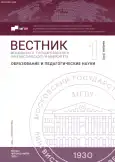The Relationship Between Empathy and Changes in Pupil Diameter When Perceiving Photo Images of Various Categories
- Authors: Troitskaya E.A.1, Marchenko O.P.1,2
-
Affiliations:
- Moscow State Linguistic University
- Moscow State University of Psychology and Education
- Issue: No 1(846) (2023)
- Pages: 71-78
- Section: Psychological studies
- URL: https://journal-vniispk.ru/2500-3488/article/view/348775
- ID: 348775
Cite item
Full Text
Abstract
The article presents the results of a research aimed at testing the hypothesis of the relationship between changes in pupil diameter when perceiving photo images of various categories and the peculiarities of empathy. The research involved 62 subjects whose pupil diameters were recorded using an eye tracker. Patterns of change in pupil diameter were revealed for three groups of subjects with different ratios of empathy structural components.
About the authors
Elena Avenirovna Troitskaya
Moscow State Linguistic University
Author for correspondence.
Email: ea.troitskaya@mail.ru
PhD (Psychology), Associate Professor, Associate Professor of the Department of Psychology and Pedagogical Anthropology, Institute of Humanities and Applied Sciences, Moscow State Linguistic University
Russian FederationOlga Pavlovna Marchenko
Moscow State Linguistic University; Moscow State University of Psychology and Education
Email: olga.p.marchenko@yandex.ru
PhD (Psychology), Associate Professor of the Department of General Psychology, Moscow State University of Psychology and Education; Associate Professor of the Department of Psychology and Pedagogical Anthropology, Institute of Humanities and Applied Sciences, Moscow State Linguistic University
Russian FederationReferences
- Hess E. H. Attitude and pupil size // Scientific American. 1965. № 212. P. 46–55. doi: 10.1038/scientificamerican0465-46.
- Hess E. H. The role of pupil size in communication // Scientific American. 1975. № 233. P. 110–119. doi: 10.1038/scientificamerican1175-110.
- Preuschoff K., Hart B. M., Einhauser W. Pupil Dilation Signals Surprise: Evidence for Noradrenaline’s Role in Decision Making // Frontiers in Neuroscience. 2011. № 5. P. 115. doi: 10.3389/fnins.2011.00115.
- Hyönä J., Tommola J., Alaja A.-M. Pupil dilation as a measure of processing load in simultaneous interpretation and other language tasks // The Quarterly Journal of Experimental Psychology. 1995. № 48. P. 598–612. doi: 10.1080/14640749508401407
- Kret M. E. The role of pupil size in communication. Is there room for learning? // Cognition and Emotion. 2018. № 32 (5). P. 1139–1145. doi: 10.1080/02699931.2017.1370417.
- Kang O., Wheatley T. Pupil dilation patterns spontaneously synchronize across individuals during shared attention // Journal of Experimental Psychology: General. 2017. № 146. P. 569–576. doi: 10.1037/xge0000271.
- Kret M. E., Fischer A. H., De Dreu C. K. W. Pupil mimicry correlates with trust in in-group partners with dilating pupils // Psychological Science. 2015. № 26 (9). P. 1401–1410. doi: 10.1177/0956797615588306.
- Harrison N. A., Wilson C. E., Critchley H. D. Processing of observed pupil size modulates perception of sadness and predicts empathy // Emotion. 2007. № 7 (4). P. 724–729. doi: 10.1037/1528-3542.7.4.724.
- Fawcett C. et al. Individual differences in pupil dilation to others’ emotional and neutral eyes with varying pupil sizes / C. Fawcett, E. Nordenswan, S. Yrttiaho, T. Häikiö, R. Korja, L. Karlsson, H. Karlsson, E. L. Kataja // Cognition and Emotion. 2022. № 36 (5). P. 928–942. doi: 10.1080/02699931.2022.2073973.
- Cosme G. et al. Pupil dilation reflects the authenticity of received nonverbal vocalizations / G. Cosme, P. J. Rosa, C. F. Lima, V. Tavares, S. Scott, S. Chen, T. Wilcockson, T. Crawford, D. Prata // Scientific Reports. 2021. № 11 (1). P. 1–14. doi: 10.1038/s41598-021-83070-x.
- Троицкая Е. А. Особенности разработки методики исследования структурных компонентов эмпатии // Вестник Московского государственного лингвистического университета. 2012. Вып. 7 (640). С. 144–157.
- Marchewka A. et al. The Nencki Affective Picture System (NAPS): introduction to a novel, standardized, widerange, high-quality, realistic picture database / A. Marchewka, Ł. Żurawski, K. Jednoróg, A. Grabowska // Behavior Research Methods. 2014. № 46(2). P. 596–610. doi: 10.3758/s13428-013-0379-1.
- Марченко О. П. Роль фактора культуры в подборе аффективно-окрашенного стимульного материала по шкалам валентности, эраузала и доминантности для исследований лицевых экспресcий // Лицо человека: познание, общение, деятельность: коллективная монография / под ред. К. И. Ананьевой, В. А. Барабанщикова, А. А. Демидова. М. : Московский институт психоанализа, 2019. С. 165–185.
Supplementary files









